Unidentified - Australia and New Zealand
A place for temporarily storing messages about species from Australia & New Zealand until they are identified. See Unidentified -General Page for an index of unidentified categories. Please make a point of looking through these messages to see if you can help identify any of them.
Authorship detailsRudman, W.B., 2001 (June 26) Unidentified - Australia and New Zealand. [In] Sea Slug Forum. Australian Museum, Sydney. Available from http://www.seaslugforum.net/find/unidentanz
Related messages
Unidentified chromodorid? from northern New Zealand
October 15, 2008
From: Debbie Freeman
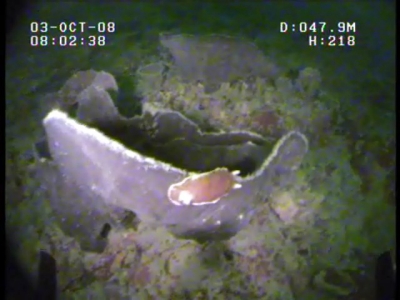
Concerning message #9402:
Hi,
I thought you may be interested to see the attached image (unfortunately of low resolution). It was taken from video footage recorded by a remote operated vehicle off the Northland coast, New Zealand, a couple of weeks ago.
Locality: Tutukaka Head (1 nautical mile offshore), 48 metres, Northland, New Zealand, Pacific Ocean, 03 October 2008, Rocky reef (heavily silted). Length: 60-70 mm. Photographer: Debbie Freeman (via ROV).
Kind regards,
Debbie Freeman.
dfreeman@doc.govt.nz
Freeman, D.J., 2008 (Oct 15) Unidentified chromodorid? from northern New Zealand. [Message in] Sea Slug Forum. Australian Museum, Sydney. Available from http://www.seaslugforum.net/find/21973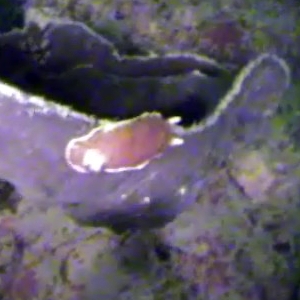
Dear Debbie,
It's difficult to see much detail, but from the shape of the body and the gills, I suspect this is a chromodorid nudibranch. In the north of New Zealand, warm currents often bring down larvae of quite tropical species. This looks quite like the chromodorid Noumea norba or perhaps its one of the other speices which look very similar [see N. purpurea colour group]. The sponge may be its food, but we would need better photos to identify either the nudibranch or the sponge
Best wishes,
Bill Rudman
Re: Dendrodoris fumata? from Western Australia
August 22, 2007
From: Bruce Potter
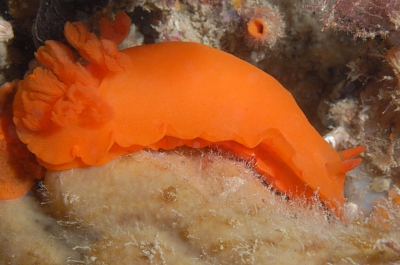
Concerning message #20153:
Dear Bill,
By sheer chance I was in Perth last weekend, so was able to dive the same site again and found the same kind of large orange nudi. I don't know if the attached image will help identify it. This one was about 75 mm long.
Locality: Rockingham, 6 metres, Western Australia, Indian Ocean, 12 August 2007, Mucky under Jetty. Length: 75 mm. Photographer: Bruce Potter.
Regards
Bruce Potter
bandppotter@bigpond.com
Potter, B., 2007 (Aug 22) Re: Dendrodoris fumata? from Western Australia. [Message in] Sea Slug Forum. Australian Museum, Sydney. Available from http://www.seaslugforum.net/find/20475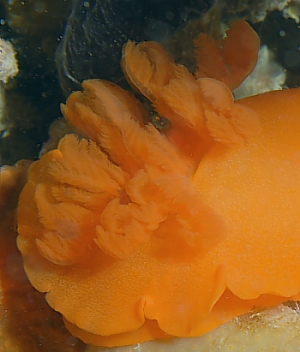
Dear Bruce,
That was a lucky find. The gills appear to be half retracted so I suspect they are more like those of D. fumata then D. nigra. However I am not convinced it is that species, as I have never seen one coloured quite like this, or with such a narrow mantle skirt. All I can ask is you keep your eye out for egg masses - they might give us a clue.
Best wishes,
Bill Rudman
Unknown Thordisa? - from Fremantle, West Australia
August 11, 2007
From: Brent Murdoch
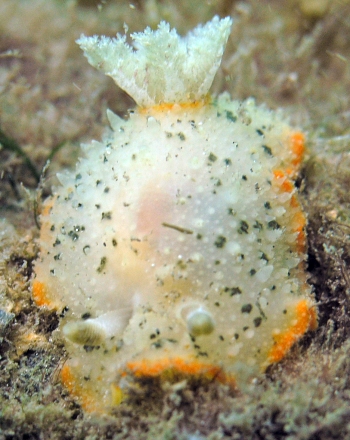
Dear Bill
There were a lot of these around in January, and a few in February. I have not been able to find anything similar.
Locality: Fremantle, Swan River, 3-8 m, Western Australia, Indian, 15 January 2007, Muddy. Length: 45 mm. Photographer: Brent Murdoch.
It seems to be either rare or new?
Thanks,
Brent Murdoch
brent@murdoch.id.au
Murdoch, B.D., 2007 (Aug 11) Unknown Thordisa? - from Fremantle, West Australia. [Message in] Sea Slug Forum. Australian Museum, Sydney. Available from http://www.seaslugforum.net/find/19500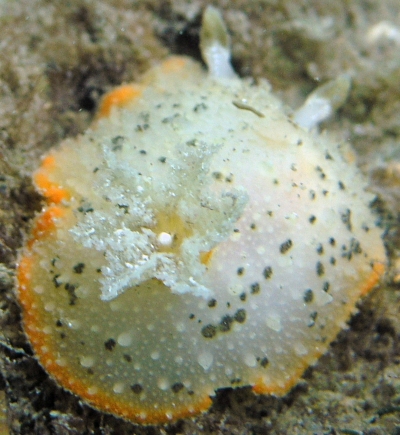
Dear Brent,
There is always the possibility that this is a species whch arrived in ballast water, but then again it could just be an example of the the vagaries of the currents carrying larvae up and down the west Australian coastline.
I don't recognise this species but it has the look of a species of Thordisa Perhaps Jamie Chan or Terry Gosliner who have recently published on this genus can give us some clues.
-
Chan, J. M. & Gosliner, T.M. (2007) Preliminary Phylogeny of Thordisa (Nudibranchia: Discodorididae) with descriptions of five new species. The Veliger, 48: 284-308.
Best wishes,
Bill Rudman
Doriopsilla carneola ? from Western Australia
August 11, 2007
From: Bruce Potter
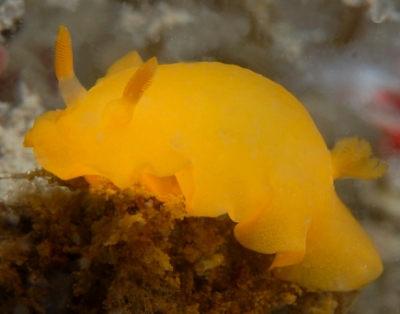
Dear Bill,
I found this fellow on a mucky dive under a small jetty near Rockingham in Western Australia. Would it be Doriopsilla carneola?
Locality: Rockingham, 7 metres, Western Australia, Indian Ocean, 4 April 2007, Silty under jetty. Length: 35 mm
Regards
Bruce Potter
bandppotter@bigpond.com
Potter, B., 2007 (Aug 11) Doriopsilla carneola ? from Western Australia. [Message in] Sea Slug Forum. Australian Museum, Sydney. Available from http://www.seaslugforum.net/find/20154Dear Bruce,
It could be D. carneola or Doriopsilla aurea but both of those usually have some white marks or spots, and the mantle is usually thicker and stiffer than you animal appears to be, and I have never seen such a bright yellow form of Dendrodoris nigra. I'm afraid I admit defeat
Best wishes,
Bill Rudman
Mystery from southern Queensland
November 21, 2006
From: Bruce Wilkie
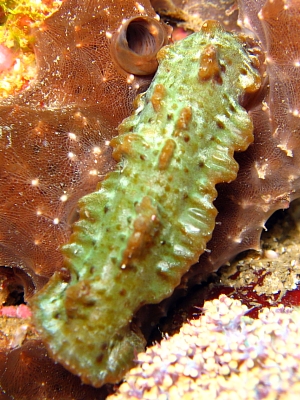
Hi Bill,
I took these photo`s twelve months ago and I am was not sure if the object on the sponge is a nudibranch or not. I have been back to the same sponge many times hoping to find it again, but with no success.
Locality: Flat Rock North Stradbroke Island, 14 metres, Queensland Australia, Pacific ocean, 20 november 2005, rocky reef with sponges, hard & soft corals . Photographer: Bruce Wilkie.
A friend of mine thinks it is a nudibranch, but I have not been able to id it. Can you help?
Many thanks,
Bruce Wilkie.
brucedwilkie@yahoo.com.au
Wilkie, B., 2006 (Nov 21) Mystery from southern Queensland. [Message in] Sea Slug Forum. Australian Museum, Sydney. Available from http://www.seaslugforum.net/find/18451Dear Bruce,
Sorry I can't help. It certainly doesn't look like any nudibranch I know. I am not even sure what it is. It could be a flattened holothurian, or possibly a flatworm but without a better idea of its anatomy I can't be sure. I know its not always possible, but if I see a mysterious animal I give it a gentle prod and if possible turn it over. Only by doing that can you find the clues which will hopefully give you an idea of what phylum your mystery belongs to. Although many animals can disguise themselves from above, its not often that they can completely hide their tube feet, or parapodia, or foot or whatever it is that tells us what they are
Best wishes,
Bill Rudman
Tiny Fiordland Aeolid
May 17, 2006
From: Ian Skipworth
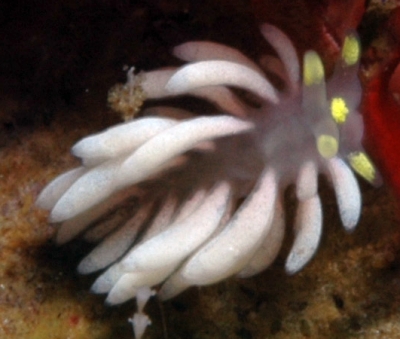
Hi Bill
Here's yet another unknown slug. I found two of these on the same dive. Both had the distinctive yellow dot in front of the rhinophores. I've not seen anything similar before and your thoughts on its identification would be much appreciated.
Locality: Nine Fathoms Passage, Dusky Sound, 10m, Fiordland, New Zealand, Tasman Sea, 9 May 2006, Rocky reef. Length: 6mm. Photographer: Ian Skipworth
Cheers
Ian
ianskip@xtra.co.nz
Skipworth, I.R., 2006 (May 17) Tiny Fiordland Aeolid. [Message in] Sea Slug Forum. Australian Museum, Sydney. Available from http://www.seaslugforum.net/find/16606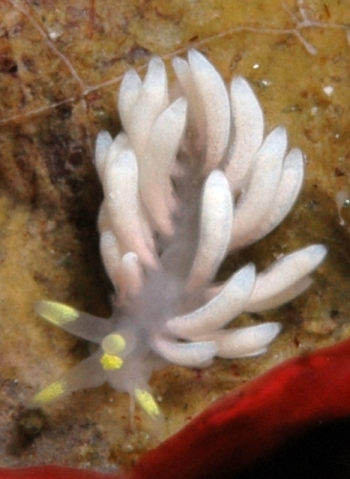
Dear Ian,
I am pretty sure this is a species of Cuthona. The distinctive colour pattern should make this species instantly identifiable, but I can find no described species with this colour pattern. I suspect this is another unnamed species. It deserves a page rather than being hidden on an 'unidentified page' but I will wait a while in case someone recognises it.
Best wishes,
Bill Rudman
Unknown Aeolid from Kermadec Ids
May 9, 2006
From: Ian Skipworth
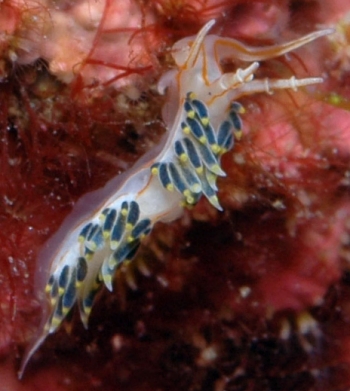
Hi Bill
I have tried to identify this little aeolid without any success. Your comments would be much appreciated.
Locality: Denham Bay, Raoul Island, 12m, NZ, Pacific Ocean, 22 March 2006, Rocky reef. Length: 10mm. Photographer: Ian Skipworth.
Cheers
Ian
ianskip@xtra.co.nz
Skipworth, I.R., 2006 (May 9) Unknown Aeolid from Kermadec Ids. [Message in] Sea Slug Forum. Australian Museum, Sydney. Available from http://www.seaslugforum.net/find/16483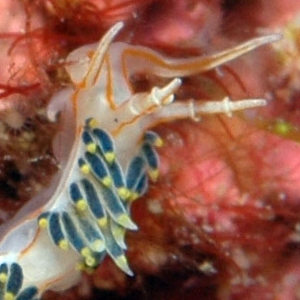
Dear Ian,
It certainly is not a species previously reported from New Zealand, but as the Kermadec Islands are probably best considered part of the wider Indo-West Pacific I looked further afield, but have not found a description matching your animal. From its general shape and ceratal arrangement I would say it is most probably a species of Phidiana. The colour pattern, with its distinctive orange lines, and the shape of the rhinophores, with two ridges or brackets, which seem to be notched anteriorly and posteriorly, should make this species instantly identifiable if it has been described.
I'm afraid I can't find it. Perhaps someone else will recognise it. Failing that, I suspect it is an undescribed species.
Best wishes,
Bill Rudman
Re: Unknown dorid from Western Australia
April 14, 2006
From: Mick Tait
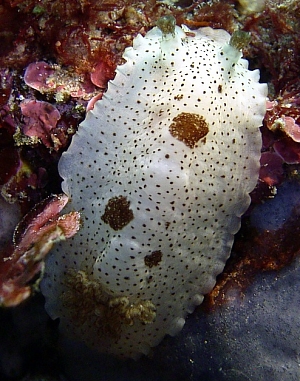
Concerning message #16287:
Bill,
Thank you for your reply. I ended up taking 7 photos of this specimen. All photos show similar proportions, with no indication of elongation or stretching. After looking closely at the photos, I would have to say that the body is opaque, even at the edges. There are signs of pustules that are slightly more apparent on the other photos.
Regards,
Mick
mick@bluesphere.com.au
Tait, M, 2006 (Apr 14) Re: Unknown dorid from Western Australia. [Message in] Sea Slug Forum. Australian Museum, Sydney. Available from http://www.seaslugforum.net/find/16313Dear Mick,
Thanks for another photo. I've had another think about it and still think Dendrodoris elongata is a possibility, but looking at the high rhinophore pockets, which hide most of the rhinophore stalk, made me wonder if it could possibly be a species of Aphelodoris? However there is no way of knowing unless you come across it again. If you do you can poke it a bit and see if it greatly elongates, but failing that try and turn it over and look at its head - not that easy underwater -. If the head has proper tentacles [see dorid head Fact Sheet] then it is not a Dendrodoris and so Aphelodoris becomes a real possibility. Unfortunately I haven't got a head of Dendrodoris in the Forum at present for you to compare, but its head merges with the foot and has no distinct tentacles.
Best wishes,
Bill Rudman
Unknown dorid from Western Australia
April 12, 2006
From: Mick Tait
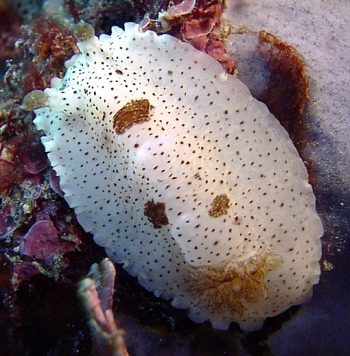
I can't find a match for this nudibranch photographed at Rottnest Island. Your assistance with identification will be appreciated.
Locality: Rottnest Island, 20m, Western Australia, Indian Ocean, 08 April 2006, Reef. Length: 40mm.Water Temp 20 Deg C. Photographer: Mick Tait.
Thank you in advance.
Mick Tait
mick@bluesphere.com.au
Tait, M, 2006 (Apr 12) Unknown dorid from Western Australia. [Message in] Sea Slug Forum. Australian Museum, Sydney. Available from http://www.seaslugforum.net/find/16287Dear Mick,
I may need some more information on this, if you have it. I am pretty sure it is a species of Dendrodoris as the skin looks quite thin and translucent. The species that comes to mind is Dendrodoris elongata. It is by no means a perfect fit in colour pattern, but the ruffled edge to the mantle suggests it has a lot of 'stretch' available. Did you by chance notice the animal moving? If so, was it able to stretch out like the photos of D. elongata on the Forum?
Dendrodoris albopurpura is also a possibility, but again it stretches out and the black spots are usually on pustules and surrounded by a white ring. Another one with black spots, thin mantle and ruffled edge is D. guttata, but in that species there is an orange-brown background colour. It is possible your animal is a new species, but it is also possible that it is one of these three species in which the backround colour is absent. My suspicion is that it is D. elongata so if you have any other background information on its movement and whether it can elongate, I would like to hear about it.
Best wishes,
Bill Rudman
Unknown chromodorid from Ningaloo Reef
February 9, 2006
From: Kristin Anderson
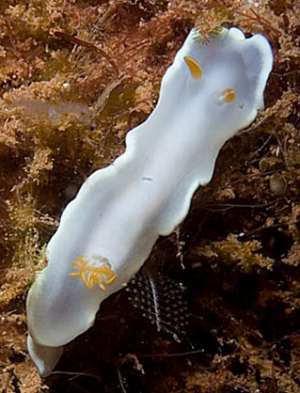
Found this the other day and am not sure what it is.
Locality: Exmouth Gulf; Ningaloo Reef, Western Australia. Depth: 7 m. Length: 2 cm. 08 Jan 2005. tidal, limestone reef, silty. Photographer: Kristin Anderson
Kristin Anderson
kristin@OceansByAnderson.com
Anderson, KJ, 2006 (Feb 9) Unknown chromodorid from Ningaloo Reef. [Message in] Sea Slug Forum. Australian Museum, Sydney. Available from http://www.seaslugforum.net/find/15696Dear Kristin,
I suspect this is a chromodorid of some sort, but I think we would need to look at its anatomy to be sure what genus.There are many white species with orange markings but I don't remember this one. There seems to be a yellowish band at the mantle edge but I am not sure if that is just a trick of the light.
Best wishes,
Bill Rudman
Aeolid from Jervis Bay, NSW, Australia
September 10, 2005
From: Sue Newson
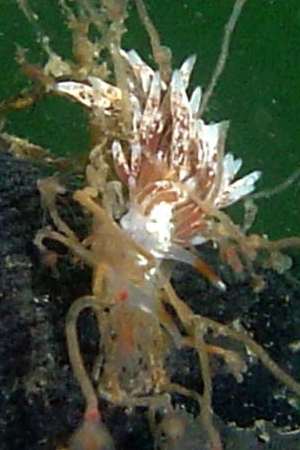
Hi Bill,
I found this small Aeolid on the hull of a moored yacht. Due to it's small size and water movement at the time, I had to detatch it with the growth it was amongst to take the photos. Can you help to identify this one?
Locality: Jervis Bay, NSW, Australia. Length: 10 mm. 26 May 2005. On hull of yacht. Photographer: Sue Newson
Regards,
Sue
suenewson@optusnet.com.au
Newson, S, 2005 (Sep 10) Aeolid from Jervis Bay, NSW, Australia. [Message in] Sea Slug Forum. Australian Museum, Sydney. Available from http://www.seaslugforum.net/find/14670Dear Sue,
This is almost certainly a species of Cuthona, but our present understanding of the group is such that I wouldn't hazard a guess at is identity. As you have found I suspect some species of this group travel around the world on the bottom of yachts like this so it could have come from anywhere.
Best wishes,
Bill Rudman
Unknown dorid from New Zealand
June 1, 2005
From: Ian Skipworth
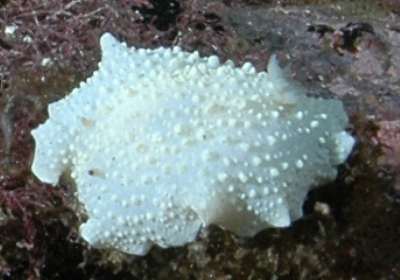
Hi Bill
Apologies for the quality of this photo. It was taken with a highly unsuitable 10.5mm fisheye lens. I was hoping I'd find another with the macro lens on but didn't. There's a second slug behind the front one which makes its shape less distinct. Rhinophores can just be seen to the left. One has a dark coloured tip. Gills are to the right. Any comments much appreciated.
Locality: Shag Islands, Dusky Sound, Fiordland. NZ. Depth: 10 m. Length: 40 mm. 6 May 2005. Rocky reef. Photographer: Ian Skipworth
Cheers
Ian
ian@ianskipworth.com
Ian Skipworth, 2005 (Jun 1) Unknown dorid from New Zealand. [Message in] Sea Slug Forum. Australian Museum, Sydney. Available from http://www.seaslugforum.net/find/13913Dear Ian,
I have to admit defeat with this one. It certainly does not look like any species I am familiar with so I looked through some of the old literature. In the 1800s quite a few species were described from New Zealand on the basis of preserved animals. No information was collected on the colour or shape of the living animals. A number of tuberculate dorids were described but none seem to fit your animal. Without some information on its anatomy I'm afraid I could only make a wild guess as to what genus it belongs to.
Best wishes,
Bill Rudman
Nudibranch from New Zealand
June 1, 2002
From: Mereana Pou
Kia ora (Greetings) from Auckland, New Zealand. I have recently completed my Advanced Open Water Dive Certificate with Dive HQ - Greenland, Auckland (PADI International).
One of the requirements for this certificate was Marine ID. On this dive I saw little creature that I would have to say, has been the most stunning creature that I have ever seen in the water and on land. I described it to my instructor as being a little white slug about 4 cm long (with my mask on!!!). It had a purple outline on its skirt, yellow spots on its back, purple "ears" and blue eyes. After a while of thinking about it, she proclaimed that it might be a nudibranch.
I jumped on the net to try and find this creature only to discover that there are so many nudibranches that this could be almost impossible for me to find it. The closest I could find has been the Clown Nudibranch. I saw this creature of the North East Coast of New Zealand at a place called Cape Rodney. I was at a depth of 10 m and the water temperature was about 16 degrees.
Is there anyone out there who could help me to identify this creature and does anyone have a picture of it? I have been given an assignment to do and I would very much like to research this nudibranch. I look forward to hearing from anybody about this!!!
Mereana
ata01@ata.ac.nz
Pou, M., 2002 (Jun 1) Nudibranch from New Zealand. [Message in] Sea Slug Forum. Australian Museum, Sydney. Available from http://www.seaslugforum.net/find/7126Dear Mereana,
I am afraid that identifying marine invertebrates is quite difficult even with a good description or a photo. Unfortunately it is almost impossible for me to solve your puzzle without a photo, especially when you are not sure if it is even a slug.
The only Clown nudibranch I know of is Triopha catalinae and I don't know any NZ relative with the colour pattern you describe. One possibility is Ceratosoma amoena. Another suggestion would be to use the Forum SEARCH BUTTON and type in New Zealand. That will give you a list of the species from New Zealand that are on the Forum. If it has been reporte previously on the Forum from NZ it will make it easier for you to find a photo of it.
Good Luck,
Bill Rudman
Doto from New Zealand
December 16, 2001
From: Gareth Jones
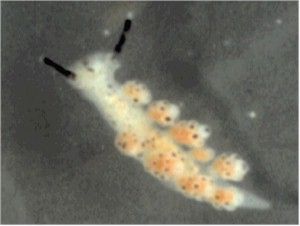
Dear Dr. Rudman,
Here is another little nudibranch I found at the Poor Knights [NE New Zealand] on the 9 December 2001, at around 5m deep. It was a very small 2-3mm. Any help with ID appreciated as always.
Cheers
Gareth Jones
rees@divenz.co.nz
Jones, G., 2001 (Dec 16) Doto from New Zealand. [Message in] Sea Slug Forum. Australian Museum, Sydney. Available from http://www.seaslugforum.net/find/5822Dear Gareth,
This is a species of Doto a group which are not that common in New Zealand and so have not been well studied. Two species have been reported from New Zealand. One of these is apparently a cosmopolitan species, Doto pita and the other has been likened to Doto bella Baba, 1938. However, D. bella, which was described from Japan, is said to have a black patch midway along each rhinophore, whereas your animal has completely black rhinophores, except for a white tip. Your animal is very similar to what is called Doto bella in Suzuki, 2000 from Japan, and Doto racemosa in Marshall & Willan 1999 from Heron Island, but as I mentioned above D. bella has a small black patch midway along the rhinophore, rather than being all black, and no black is described by Risbec for D. racemosa.
I can't be sure what species you have here but the black rhinophores are very distinctive.
Best wishes,
Bill Rudman
Unknown aeolid from New Zealand
November 14, 2001
From: Gareth Jones
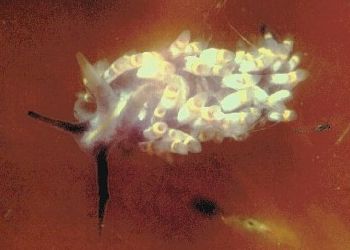
Hi Bill, We photographed this nudi' at the Poor Kknights Ids [northeastern New Zealand] on the 20 Oct 2001 near a site called southern arch. It was on a sponge covered rock wall at about 7m. The background in the photo is Ecklonia kelp. We hope you can give us a name for the 'face'. It is small, 7-8mm.
Any help appreciated
Cheers
Gareth Jones
rees@divenz.co.nz
Jones, G., 2001 (Nov 14) Unknown aeolid from New Zealand. [Message in] Sea Slug Forum. Australian Museum, Sydney. Available from http://www.seaslugforum.net/find/5560Dear Gareth,
This is an intersting find. With such distinctive black oral tentacles, this aeolid should be easy to identify - if it has a name. Is there also a black tip to the 'tail' (posterior end of foot). If you have any other photos of it I might be able to get a few details of other parts of its body. I though at first that it might be a species of Cuthona but it looks like the front of the foot might have tentacle-like extension out each side which would rule that out.
Basically I can't recall a New Zealand or southern Australian species of aeolid with this colour pattern. perhaps someone will recognise it.
Best wishes,
Bill Rudman
Gastropterid from southeastern Australia
December 26, 2000
From: John Chuk
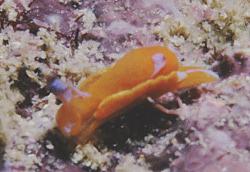
Dear Bill,
Here is the second of two species of cephalaspideans I photographed in Port Campbell Harbour, here in Victoria, [Australia] in February 1999. Unfortunately these are not great photographs as all specimens were 4mm in length and fine detail is lacking.
[See separate message for first species]
The second species is bright orange in colour with several small pale purple markings. The posterior border of the cephalic shield is raised into a siphon-like structure the tip of which is pale purple in colour, or almost black in some specimens. Parapodia are visible. Five specimens of this species were found and all were found at 3.5m depth on reef covered with a low growth of calcareous red and filamentous brown algae. I suspect that this species belongs to the family Gastropteridae?
Any help in identifying it would be gratefully appreciated!
John Chuk
jchuk@giant.net.au
Chuk, J., 2000 (Dec 26) Gastropterid from southeastern Australia. [Message in] Sea Slug Forum. Australian Museum, Sydney. Available from http://www.seaslugforum.net/find/3437Dear John,
Your animal is indeed a gastropterid, probably a species of Siphopteron, but at this moment I am not sure whether it is an undescribed species or a colour variation of one of the tropical species with a similar colour pattern. I have found this species in many parts of southeastern Australia and the colour pattern is quite variable.
Best wishes,
Bill Rudman
